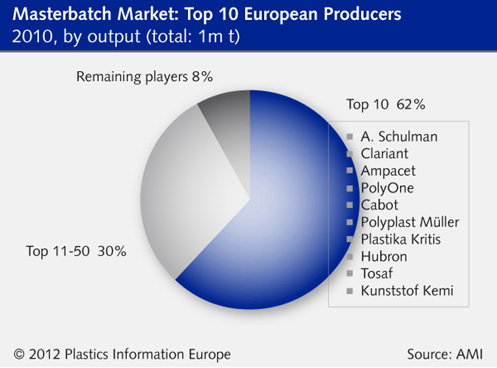
| Although the medium-term prospects for Europe�s masterbatch industry are not exactly exciting, the market is nevertheless expected to grow at a modest 2% pa in the near future. Europe�s masterbatch consumption rose by an average 2% pa in the period from 2005-2010, reaching an overall market value of EUR 2.9 bln in 2010. In volume terms, Eastern Europe and Russia are expected to see above average consumption growth of about 2.5% pa, shoring up demand development for the entire continent. Given these prospects, European masterbatch consumption is set to rise from its present 900,000 tons to about 1mln tons by 2015, as per Applied Market Information. Contrary to Asia, where masterbatch demand is set to see the world�s highest growth rates amid China�s rapid economic development, Europe�s masterbatch industry is more mature. Following a dramatic alignment as a result of the 2008-2009 financial crisis, at a time when European producers were already grappling with lower growth rates, the situation has calmed down. With no more room for consolidations, few players have entered the European masterbatch scene in recent years and the M&A activities of existing producers have also abated. One of the new trends, however, is the rise in investments by US companies, particularly in Eastern Europe. The global masterbatch market has not experienced its fair share of turbulence over the past few years, as a result of which many of the companies listed in the report have significantly altered both their market and product focus. Several leading players have significantly curtailed their European activities, for example, a development often accompanied by site closures. Others have tried to encourage long-term growth by enlarging their product portfolio and/or entering the new and larger markets in Eastern Europe or further afield. The economic uncertainty of the past few years has also resulted in significant financial realignments, as some European masterbatch producers have seen their margins contract to the point of threatening their very existence, while others seized the opportunities presented by just-in-time smaller deliveries to improve both margins and profitability. 
In its study of Europe�s thermoplastic masterbatch market, AMI differentiates among black, white, colour and additive masterbatches. The latter two are available either as resin, paste or powder. With an overall output of about 1 mln tons, Europe�s masterbatch market is equally divided among these four categories in volume terms, although in terms of value, colour masterbatches alone account for 40% of the total market value, while the black alternatives account for the smallest market share. The report shows that market leaders A. Schulman and Ampacet, for instance, have significantly enhanced their portfolio in the past few years, especially with regard to specialty colour masterbatches. Further solidifying its European colour masterbatch business, A. Schulman announced its acquisition of Vita Group�s French colour masterbatch producer Elian, estimated to make it France�s third-largest colour masterbatch producer. Other companies, including Israel�s Tosaf or Plastika Kritis have focused on expanding sales in new markets. The black masterbatch market, which AMI calls truly European, underwent a number of changes in the wake of the global financial crisis. Leading US producer Cabot significantly restructured its European activities, including the closure of production sites in the UK and Italy, choosing to focus its activities on the growth markets in the Middle East and Asia instead. As several larger players withdrew from Europe, new opportunities arose for the independent sector, including British market researchers Hubron and Polyplast M�ller. Faced with an ongoing tight titanium dioxide market, white masterbatch producers continue to feel the pressure of rising raw material prices, hence AMI predicts significant structural changes in this sector. Leading European white masterbatch producers are A. Schulman and Ampacet. Europe�s additive sector is particularly heterogeneous, not least because of the huge product variety in this field. Amid the difficult economic climate and the euro crisis, AMI predicts that most masterbatch producers will continue to focus on realignment in the near future. Another ongoing trend is the investment in Eastern Europe. |
Previous Article
Next Article
{{comment.DateTimeStampDisplay}}
{{comment.Comments}}